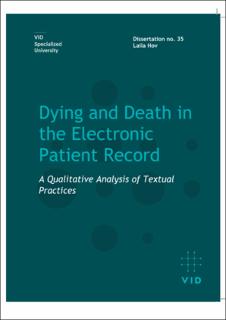| dc.description.abstract | In Norway, over one in four deaths occur in hospitals, places that operate primarily according to curative logic. One aim of the Norwegian health care system is that patients, at the end of life, should receive high-quality palliative care as defined by the World Health Organization, independent of whether they are dying at home or in a nursing home, hospice or hospital. Against this potentially challenging background, this project investigates the role of the texts about such patients written into the electronic patient record (EPR).
Starting from the view of (EPR) texts as active contributors to the whereabouts of (dying) patients, the EPR can be seen as an essential communication and coordination tool contributing to the types of knowledge that circulate about the dying patient and their treatment. This thesis aims to provide insights into how and what knowledge the EPR proposes as relevant by asking: What kind of textual practices of dying and death in medical wards are present in the EPR, and what do these practices achieve?
The selected methods were a qualitative document analysis combining elements from the fields of linguistics, literary criticism and science and technology studies. This effort resulted in three articles elaborating different aspects of how dying and death are documented in the EPR. The first article investigated the negotiations of the transition from curative to palliative care. It argued that the text often changes from being technical and conclusive to being uncertain and open to negotiations as a need to align the involved parties in the decision. The second article explored which aspects of dying the text is attuned to in patients’ last 24 hours of life. It argued that the text has three hegemonic modes of ordering – numbering, timing, and classifying – which perform a dominant narrative in which dying is concealed. Yet, in between, there are traces of caring attention to and compassion for the dying patient. The third article considered how the moment of death is documented. It argued for what seem to be established ways of recording this moment as being manageable and portraying it as uneventful or good.
This exploration of textual practices suggests that, first, the EPR treats dying and death as observations and tasks to be solved in general biomedical terms, rather than probing the needs of the individual patient. Second, the EPR seems to avoid difficult topics, deliberations, and disagreements, and it never admits to failure. Finally, the EPR sometimes shows professionals’ attempts to reveal individual patients’ needs and suffering and the troubles of dying in a curative context.
Paper I: Hov, L., Synnes, O., & Aarseth, G. (2020). Negotiating the turning point in the transition from curative to palliative treatment: A linguistic analysis of medical records of dying patients. BMC Palliative Care, 19 (1), 1–13. https://doi.org/10.1186/s12904-020-00602-4
Paper II: Hov, L., Pasveer, B., & Synnes, O. (2020). Modes of dying in the electronic patient record, Mortality, https://doi.org/10.1080/13576275.2020.1865294
Paper III: Hov, L., Tveit, B., & Synnes O. (2021, May). Nobody dies alone in the electronic patient record – A qualitative analysis of the textual practices of documenting dying and death. OMEGA-Journal of Death and Dying. https://doi.org/10.1177/00302228211019197 | en_US |
